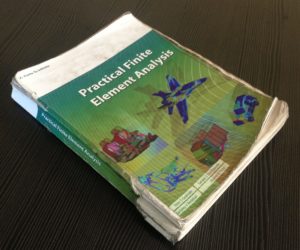Practical Finite Element Analysis, Finite to Infinite, 2008
I had always planned on writing a textbook on this subject because I hadn’t found one that was any good, but then I found someone had already done it in India. This book is hard to find, I found my copy while browsing the Tata Bookshop in Bangalore India after my friend Rajesh had shown me his copy. This book is so good. I hadn’t had a best FEA book on my best of book-list because I didn’t think there was one out there. This is it. It’s $10 if you pick up a copy in India, otherwise, it will cost you $85 for the international hardbound. It’s worth 5 times that much.
Reading this book is like having a casual conversation with your company’s old-timer who is full of knowledge, easily approachable, and likes to try to put things in perspective with directly actionable guidance and a good story to back it up.
How many tri3 elements are okay to have in my mesh (max of 5%). This image accompanies a discussion of what a professional mesh looks like. It’s eye opening. Do you know your mesher that well? Few if any of my ‘professional’ meshes look that good, and it inspires me to re-read my preprocessors section on meshing and be better.
The authors use Hyperworks for most of their examples, and it highlights what a very good tool Hypermesh is for meshing. The ‘rules of thumb’ are usually presented with an FEA trade study showing how the rule of thumb is actually the asymptote of a trade study. A number of detailed examples are presented, showing the reader not only how these guidelines were derived, but showing the gamebook for how to build your own rules of thumb for your application or industry. My experience is primarily aerospace, primary structure, linear stress, and dynamic analysis. In those areas, with my experience, I agreed with the recommendations.
Then, the book expanded into non-linear, fatigue, NVH (noise-vibration-harshness), crash, and CFD (computational fluid dynamics). In these chapters, it describes how meshes for each of these analyses have different requirements and demonstrates it with very good graphics. I had no idea about the limitations of crash analysis mesh quality. Crazy. The last two chapters of the book are worth the price of the entire book. They are titled “Common Mistakes and Errors” and “Preparation for Interview.” In Common Mistakes, there is an amazingly frank discussion about Engineers, Marketing, group leaders, and HR. My favorite part follows:
“9) Not CAE but Design engineer is the most important person in Design Chain: CAE Engineers are usually highly qualified, paid higher salaries and sometimes it leads to superiority complex (that they are the most important people in design cycle process). But it should always be remembered that the Design Engineer is the most important person and role of CAE engineering is to provide analysis services to him (other service providers are test, purchase, manufacturing, etc.).”
I agree. Analysis is a support role. We serve at the pleasure of the design function. A good design will succeed without all of our fancy computational models. We might be needed to justify this fact, but there are other ways: test, demonstration, similarity to previous designs, etc.
The last chapter on interviewing is very good. I’m glad I’m senior enough to not get asked a rapid-fire set of questions like the ones presented. I’m not sure if I would pass! Here’s a good one, “What is symmetric boundary condition? Can we use it for dynamic analysis?” If your organization doesn’t have good canned technical questions for CAE, this is a great starting point.
This book is a must for all analysis libraries and FEA analysts. I bought 5 copies in India to bring back and give to my clients and friends.
Practical Finite Element Analysis, Publisher: Finite to Infinite, 416 pages, $85 International
-ejr

